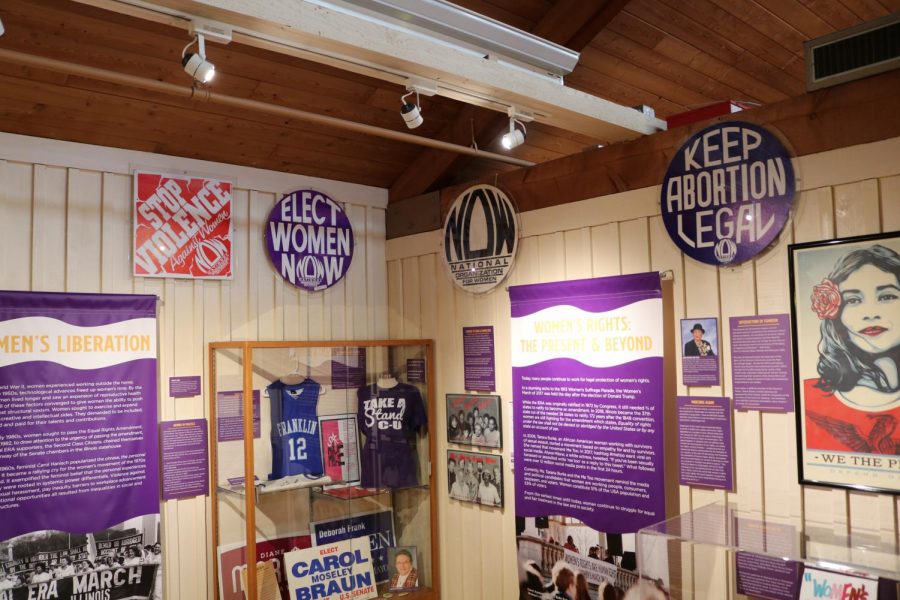How long must women wait: 19 suffragists, 19 historic homes
Photo Courtesy of Katie Snyder
The “70’s and 80’s Wall” of the “How Long Must Women Wait” exhibit at the Museum of the Grand Prairie rests in the corner of a room. The museum gave a lecture entitled “19 Suffragists, 19 Historic Homes” on Thursday.
February 2, 2021
“Remarkable women have lived and live all around you,” said Dr. Barbara Garvey, director of the Museum of the Grand Prairie, on Jan. 28 at her lecture entitled 19 Suffragists, 19 Historic Homes. This lecture was part of the Museum of the Grand Prairie’s Exhibit, “How Long Must Women Wait.”
Garvey has been interested in women’s rights studies her whole life, having a mother who advocated for the movement and growing up with feminist influences. With a Bachelor’s Degree in Anthropology and Art History from Indiana University, Bloomington and Ph.D. in Art History from UIUC, Garvey is fascinated by the way historical artifacts can tell us so much about the past.
Garvey was inspired to delve deeper into the subject after the 2016 presidential election and the Women’s March in response to it.
“It occurred to me that my grandmothers were grown women before they were able to vote. They were so close to not being able to have a say in their own destiny,” Garvey said.
From there, the idea for the “How Long Must Women Wait” exhibit was born, highlighting women’s rights and suffrage in Champaign County. The exhibit contains artifacts from the 70s/80s feminist movement, 2016 Women’s March and more. These artifacts not only contain information about the history of the women’s rights movement but also highlight the importance of the grassroots aspect of the movement, specifically in the Champaign Urbana community. With the majority of the creation of the exhibit designed and written by women, the exhibit shows the movement from a female perspective.
Get The Daily Illini in your inbox!
“When we started doing this exhibit, one of the first conversations we had was about how this exhibit can’t come from the viewpoint of a man. So, by design, we made sure that women would spearhead the research and writing to make sure that there was no male bias,” said Mark Hanson, museum curator.
Within the exhibit, Garvey gives lectures pertaining to the issue of women’s rights and suffrage with this year’s lecture on local women in the community who were part of the movement and advocated on a grassroots level. Due to the pandemic, this year’s lecture, 19 Suffragists, 19 Historic Homes took place virtually. The theme of 19 women and 19 historic homes is based on the 19th Amendment that gave women the right to vote, a monumental achievement for the movement.
Throughout history, the women of Champaign-Urbana have contributed greatly to the cause. In her lecture, Dr. Garvey talked about Champaign’s Mrs. Julia Burnham, who was responsible for spearheading the formation of the first city hospital in Champaign. Burnham became interested in issues affecting women and children and believed that healthcare should be inclusive of these minority groups.
She also talked about Mary Busey, a member of the University of Illinois Board of Trustees who advocated for the education of more women and was part of the foundation of a library. Busey also established on-campus housing for women at the University and Busey Hall is named in her honor.
Dr. Garvey continued on about other women in the area who have contributed to the movement and eventually arrived at her final featured suffragist: Countless Other Women. Although we know the names of some of the suffragists and women’s rights advocates in the community, there are countless other women throughout history who have pushed for the equal rights and treatment of women, but remain unrecognized for their work.
BIPOC women advocated and continue to advocate for their right to vote, although they have not always been given the recognition they deserve throughout history. Even though the women’s rights movement is often thought of as a national one, it is important to understand that it had to start at a local level by everyday women who wanted a say in issues that affected them.
The exhibit was also made possible by Katie Snyder, Education Program Specialist, who was responsible for finding artifacts and creating educational materials. One project within the exhibit that allowed Snyder to work with the Champaign Urbana community was the Sisterhood Mural that illustrates the ‘doors’ or obstacles young BIPOC women face today academically as well as systematically.
“We wanted young Black and Brown women to think about what doors were closed to them because of the race, gender, etc., show how they opened these doors, and look to the future,” Snyder said.
Snyder reached out to young women at Franklin STEAM Academy in Champaign to work on this mural with the purpose of empowering young Black and Brown girls within the community.
The exhibit as a whole draws attention not only to notable local women’s rights advocates but everyday people who pushed and continue to push for change.
“It was a national movement but it was also a very grassroots movement. And those women lived in our neighborhoods and places that we pass every day. History is local as well as national,” Garvey said.







